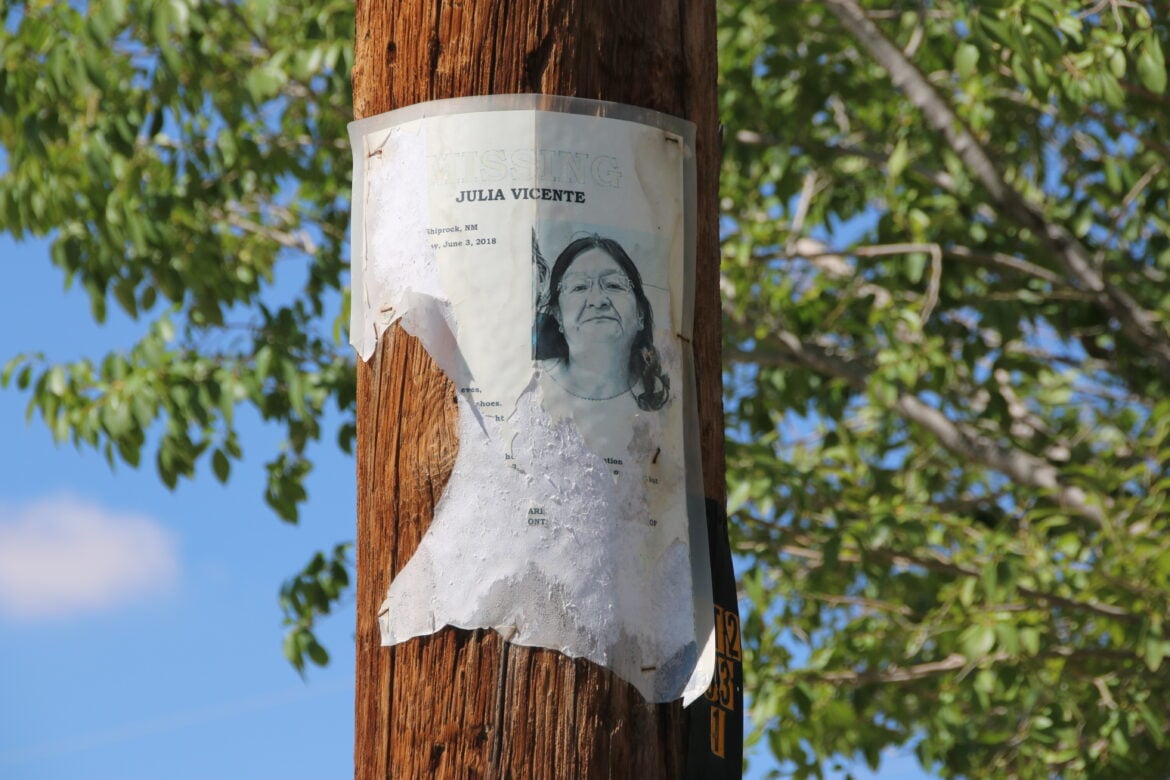Julia Vicente always walked the same route home from visiting her friend.
She’d traverse about a mile of Shiprock, a town on the Navajo Nation in New Mexico’s northwestern corner, along a dirt road through a neighborhood, bordered by hills and an irrigation canal on one side and a busy highway on the other. She’d turn onto a well-worn path that cuts around and through a few fields before coming out behind a gas station. She’d cross the highway. From there, her house was straight down a tree-lined street.
A citizen of the Navajo Nation who grew up and lived in Shiprock for most of her life, Vicente walked the path often. It was the route she planned to use when her husband dropped her off to see her friend on June 3, 2018.
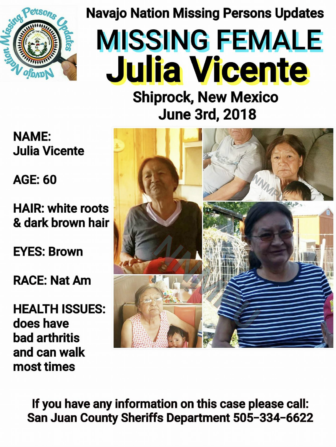
The Navajo Nation Missing Persons Updates flyer for Julia Vicente.
She didn’t return that evening. Her family hasn’t seen her since.
Vicente, 59 at the time of her disappearance, had six children and several grandchildren.
“I can still see her walking there,” said daughter Michelle Frank while driving down the street leading to her childhood home on a late August afternoon. She remembered how she would ask her mother “Hey ma, you need a ride?” if she saw her walking across town. Frank paused to take a breath, appearing to stop from crying.
Over five years later, Frank still doesn’t know what happened to her mother.
Although she’s hanging on to hope, Frank doubts she’ll ever know. The Navajo Police Department took weeks to classify her as a missing person, she said, and the family has taken to searching for Vicente themselves.
The department has not responded to New Mexico In Depth’s questions about its investigation into Vicente’s disappearance. But inadequate investigations by law enforcement agencies — including slow response times and dismissive attitudes from police — are hallmarks of the crisis of missing and murdered Indigenous people, according to national and state reports.
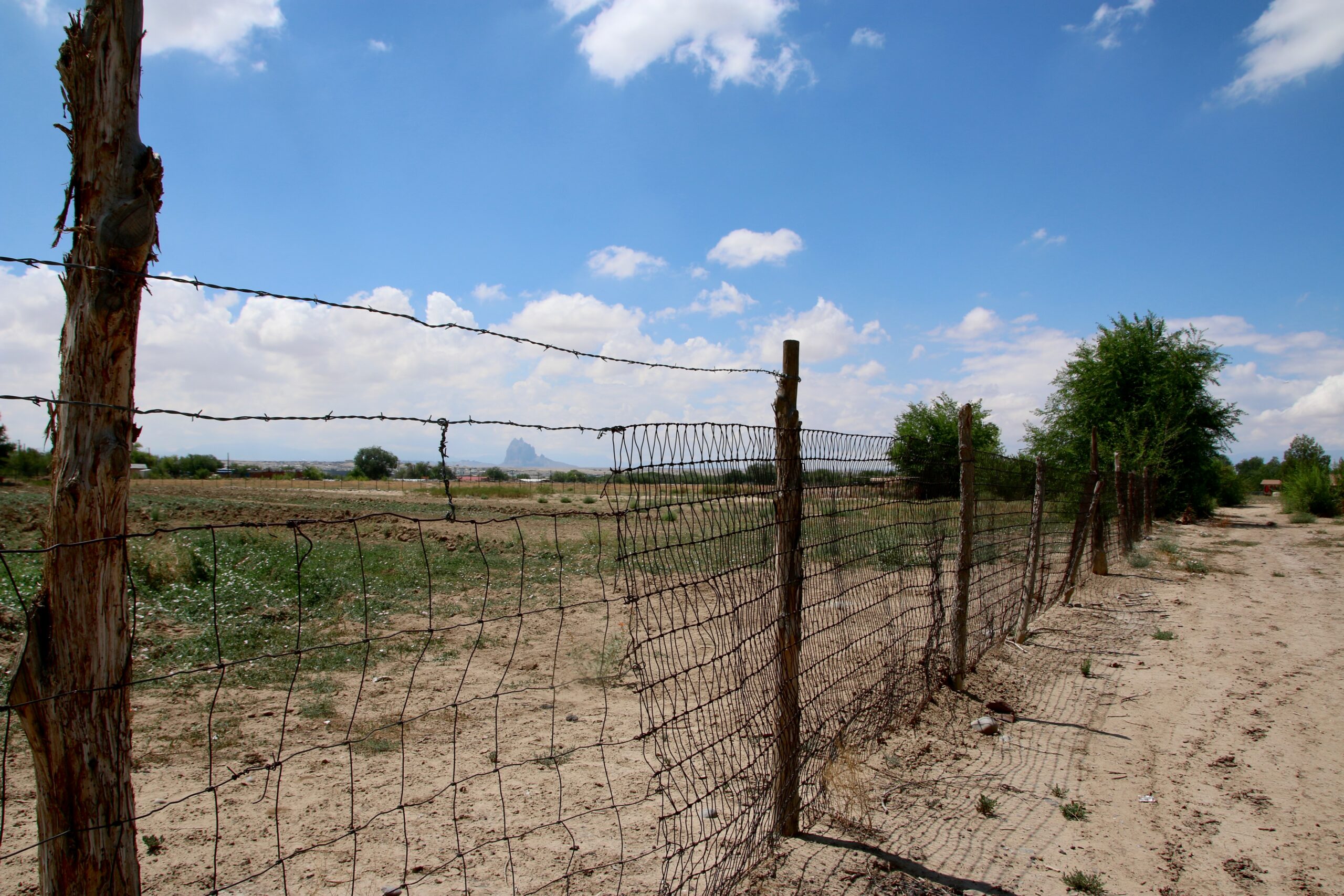
A dirt path Julia Vicente often used leads from a Shiprock neighborhood to a gas station. A natural formation, which shares the same name as the town and is sacred to the Diné, stands in the distance. Credit: Bella Davis/New Mexico In Depth
Vicente is one of at least hundreds of Indigenous people who have gone missing in New Mexico. An FBI list notes 181 Native Americans missing from the state and the Navajo Nation as of September, although officials say that’s likely an undercount. The oldest case listed is from 1956.
Gaps in data collection and a lack of coordination between law enforcement agencies make it impossible to know the exact number of Indigenous people who have disappeared or been murdered in the state and across the country.
But available figures point to a national crisis, which also plagues Canada.
More than four in five American Indian and Alaska Native (AI/AN) people have experienced violence in their lifetime, a higher rate than for non-Hispanic white people, according to a 2016 study funded by the National Institute of Justice. The vast majority of victims — 97% of women and 90% of men — have been harmed by someone who was not Indigenous. By contrast, 35% of women and 33% of men have been harmed by other Indigenous people.
And in 2020, homicide was the 12th leading cause of death for AI/AN people across all ages and sexes, according to the Centers for Disease Control and Prevention, while it was the 16th leading cause in the nation overall.
Unanswered questions
Frank, 37, was living about 20 minutes away when her mom went missing. She’s since moved back into her childhood home with her children and husband. She wanted to be closer to family and to keep her father company.
On an afternoon in August, as a couple of her kids watched TV and her teenage son helped his grandfather renovate the house’s second floor, Frank thumbed through a thick binder. Her father had put it together and it included a timeline and notes from conversations with Navajo Nation police officers and residents who knew Vicente.
Her father’s diligence in keeping details about his wife’s case organized is just one piece of the family’s efforts to get answers, which they began quickly. Disappearing for days on end wasn’t like her. She’d stayed the night at her friend’s house once or twice, but usually, she was home before dark, in time to make dinner before her husband, a local preacher, left for a service at a nearby church or nursing home.
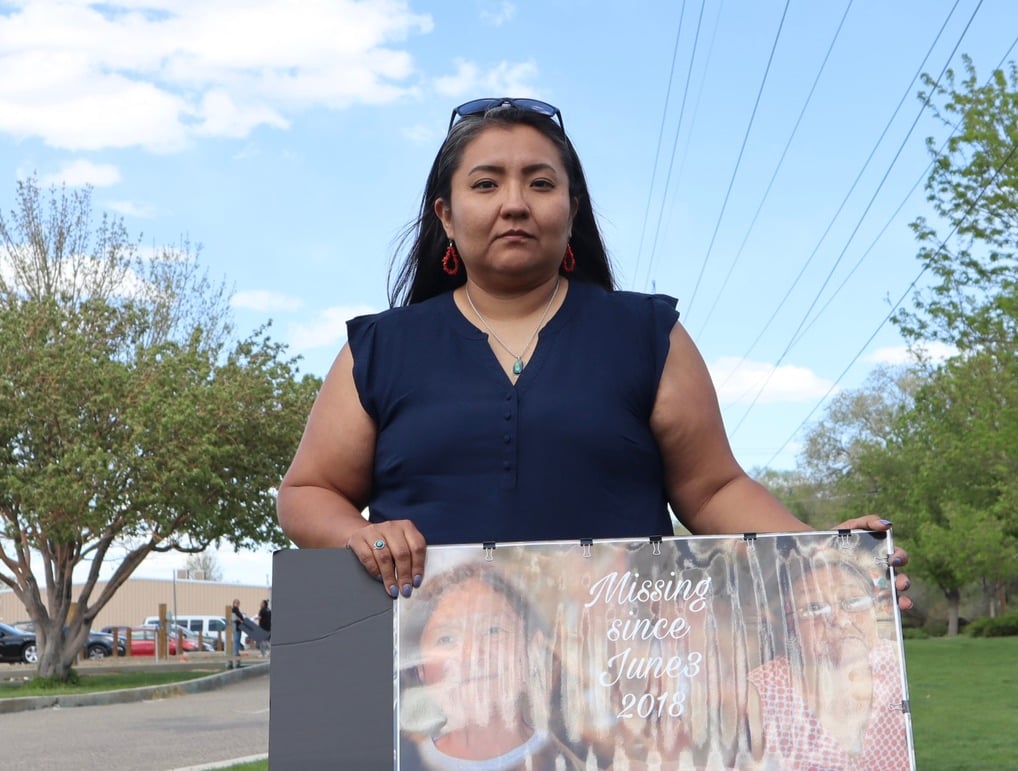
During a rally in Farmington, New Mexico in May 2023, Michelle Frank holds a poster with information about her mother, Julia Vicente, who disappeared from Shiprock over five years ago. Credit: Bella Davis/New Mexico In Depth
The family has searched canyons and dry streambeds on ATVs and horseback and hired a private investigator. They’ve gone to rallies and hung up flyers, which Frank shares on social media.
The posts don’t get much attention.
They’ve also knocked on doors in Shiprock, one of the largest towns on the Navajo Nation, to ask if anyone had seen Vicente. Some residents whom Frank thinks tired of the visits threatened them, she said, but it didn’t deter them.
“How far would you go for your mom?” Frank, a teacher’s assistant at a local school, asked.
About a month into her mother’s disappearance, the grief and uncertainty started to overwhelm her.
“I broke down a lot.”
At her husband’s suggestion, she temporarily stopped searching. Staying at home, she cooked and looked after her nieces and nephews, a decision her brothers respected. They’d been living off fast food and were happy to have home-cooked meals, she said, laughing.
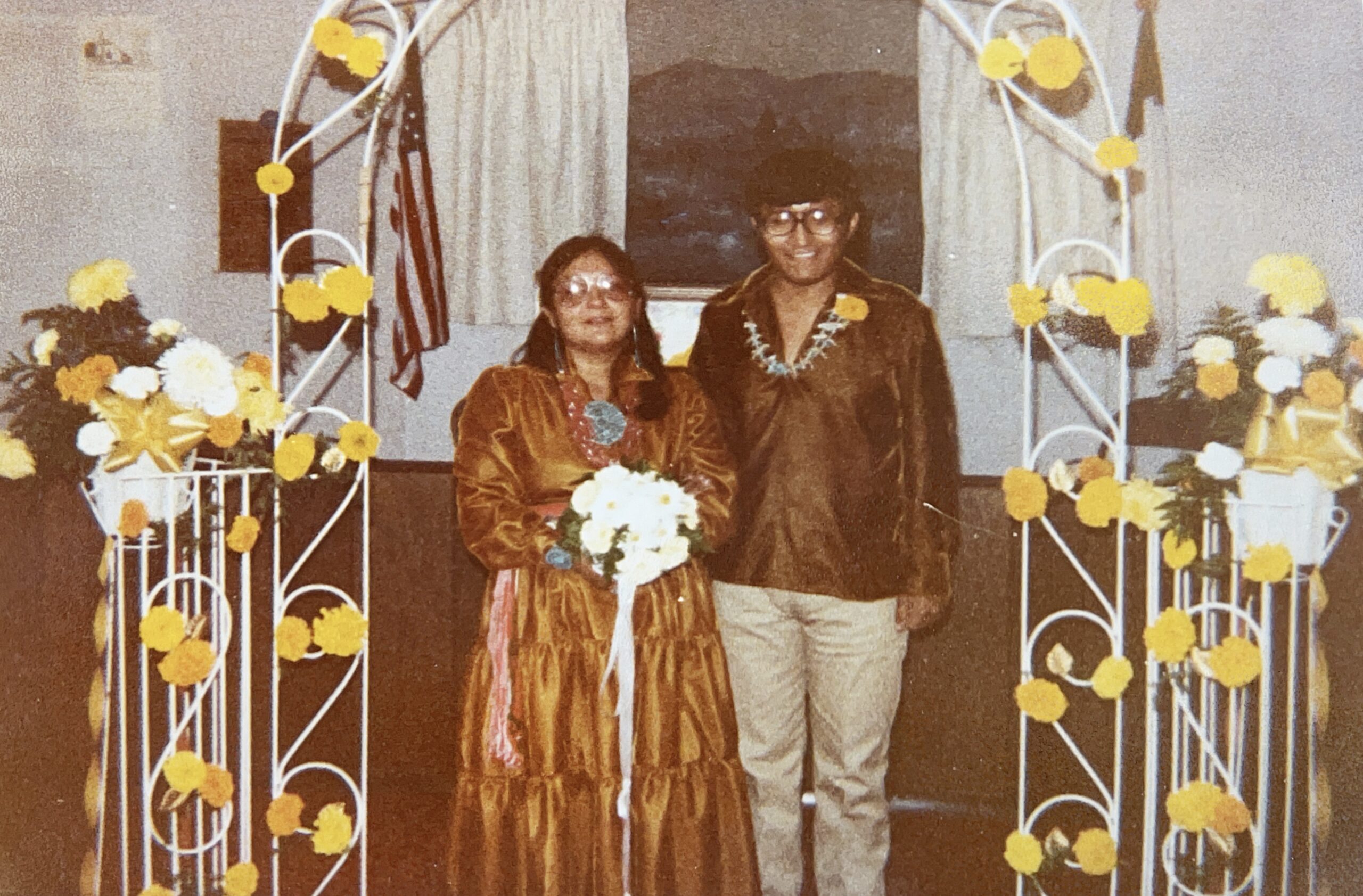
Julia Vicente and her husband, Otto Sr., on their wedding day. The pair met in Albuquerque, according to their daughter, Michelle Frank. Courtesy: Michelle Frank
Vicente’s family went to the lengths they did in part because they felt the police weren’t doing enough.
Several days after Vicente went missing, Frank’s mother-in-law told her she thought she saw Vicente walking in town the day after she went missing.
About 10 days later, one of Vicente’s cousins told the rest of the family she’d seen Vicente getting into a white truck with a couple other people, but she couldn’t be sure what day it had been. Months later, she said she thought it was possible Vicente had actually been forced into the truck.
They passed the information to police, Frank said, but nothing came of it. Their calls for updates often went unanswered.
A few weeks after her disappearance, an officer told the family Vicente wasn’t considered a missing person. When they asked why, the officer, according to Frank, said: “Because she’s an alcoholic. She left on her own terms.”
Vicente struggled with alcohol abuse, according to Frank, and many in the community knew that. But she never would’ve just left, the family told the officer.
“There’s no way she would leave and live somewhere else, especially with her grandkids,” she said.
Another month or two passed before her mother was classified as missing, as far as Frank remembers.
Frank felt optimistic last fall when a police investigator came by their house to share a theory about who might’ve been involved in Vicente’s disappearance.
“I felt hopeful, like maybe this is the year that they find something,” Frank said.
But that was the last time they heard anything.
Many other impacted families have experienced similar interactions with law enforcement.
New Mexico’s Missing and Murdered Indigenous Women and Relatives Task Force observed in a state response plan they created last year that police frequently tell families they have to wait 48 hours before a missing person report can be filed. And families are often doubted about whether their loved one is missing, which damages trust between law enforcement and communities.
“A family’s knowledge and understanding about their relative’s character and patterns of behavior should be heard and fully considered,” the plan reads.
The task force recommended the Legislature mandate law enforcement training on the issue of missing and murdered Indigenous people, with a focus on trauma-informed care, cultural humility, and how to quickly and accurately file reports. Police, the plan notes, often misclassify Indigenous people as white.
Another task force recommendation was to make liaisons available to help victims and families locate resources and navigate interactions with law enforcement. Responses like the one Vicente’s family received can retraumatize people, according to the task force’s report, and make them less likely to work with police, hindering “bringing perpetrators to justice.”
Remembering her mother
One of the things Frank feels most nostalgic for is gatherings her mother organized.
“She always tried to plan dinners just to get all of us together,” she said. “She was that type of mother. She was always there for me.”
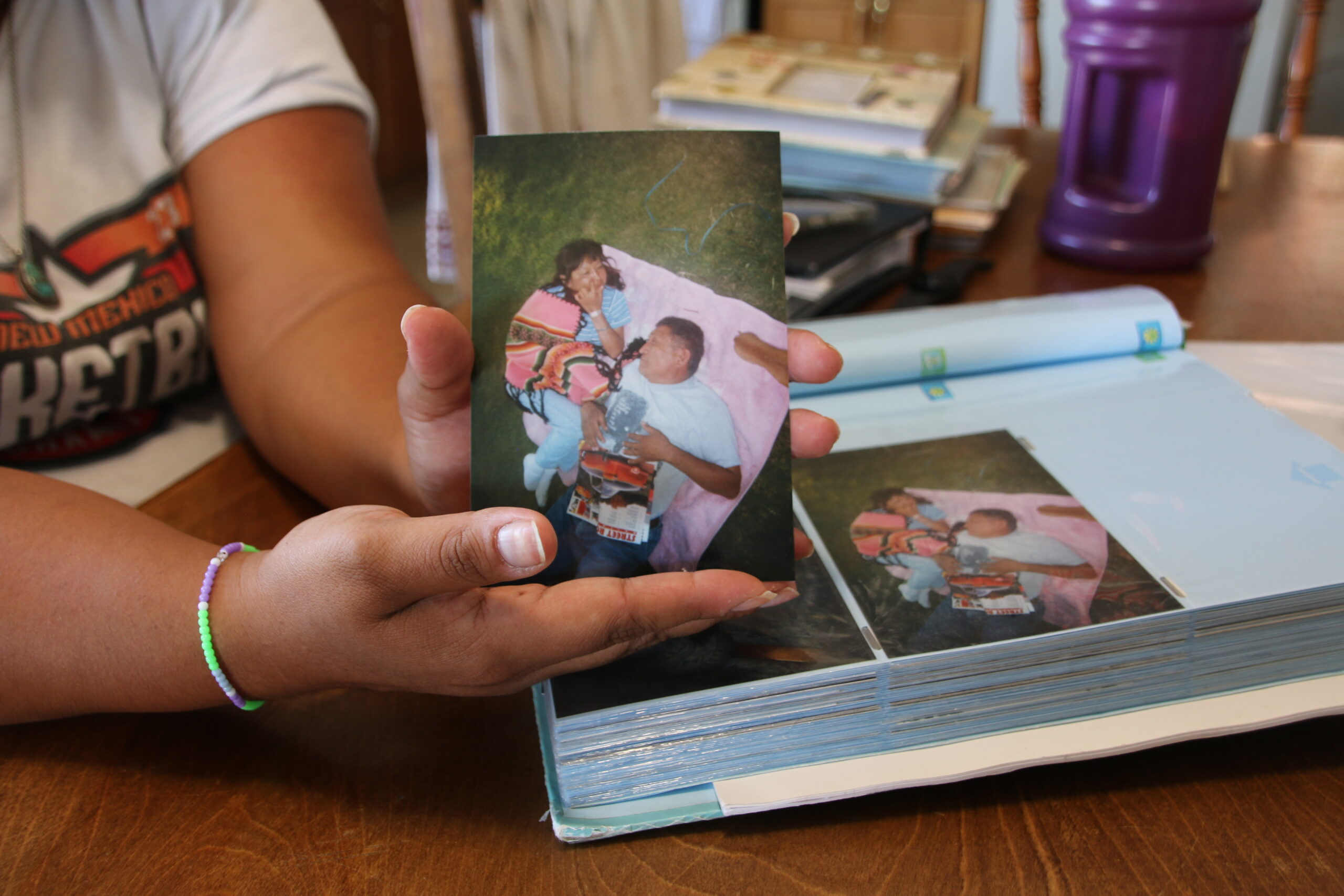
Michelle Frank, sitting at her kitchen table on Aug. 25, 2023, holds up an undated photo of her parents. Behind her are stacks of albums filled with family photos. Credit: Bella Davis/New Mexico In Depth
In the years before she went missing, Vicente often watched Frank’s children while Frank cared for her maternal grandfather, whose health was in decline from his days working in uranium and coal mines.
When she wasn’t with family and friends, Vicente enjoyed sewing and crocheting, Frank said. Her father still has a basket filled with yarn in his upstairs bedroom.
Vicente also liked going for walks around town, which helped relieve the pain from arthritis. And she loved taking trips to Colorado. Frank remembers often camping out of state as a child, something her family hasn’t done much in recent years.
“I think my dad wants to bring that back. I think he kind of didn’t want to for a long time because of my mom,” Frank said. “Even fishing. We did that a lot. The day before she went missing, we went fishing but that was, like, one day she didn’t want to go.”
Within the past year, Frank’s father brought up the idea of storing Vicente’s clothes. Surprised, Frank thought it was a healthy step.
“He’s never said he needs closure, but as the kids, we want him to have closure. We want that closure.”
Resources for impacted families
The National Indigenous Women’s Resource Center offers a reference guide outlining what to do in the first 72 hours after a loved one goes missing and a tool for assessing which law enforcement agency has jurisdiction.
The Navajo Nation Missing and Murdered Diné Relatives Task Force created a toolkit for families on the Navajo Nation that includes tips about filing a missing person report and a checklist for families to fill out with relevant information about their loved one.
